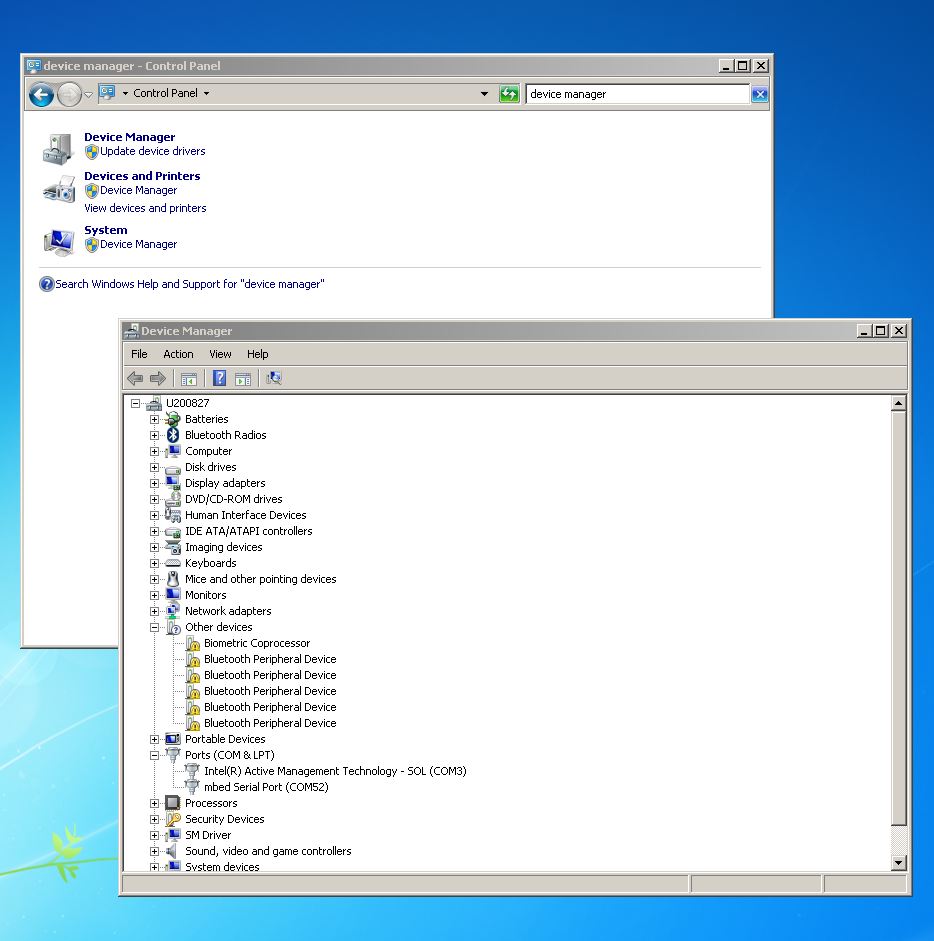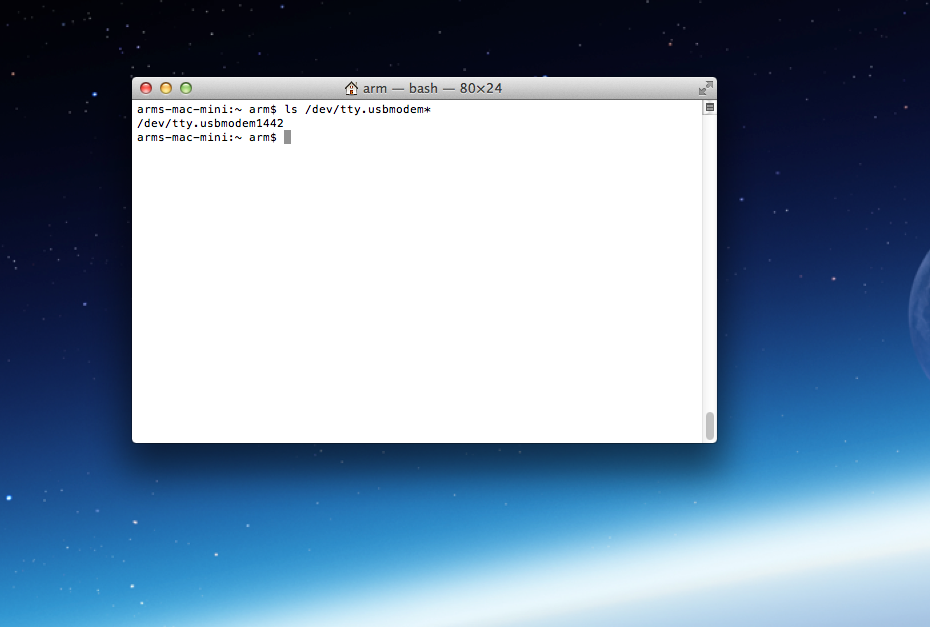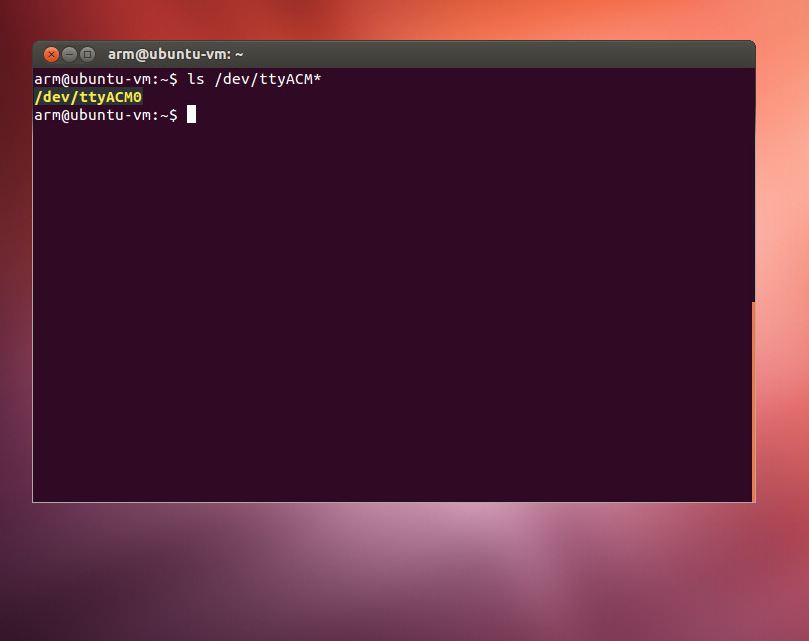FRDM-K82F
The FRDM-K82F is a low cost development platform for Kinetis® K80, K81, and K82 MCUs.
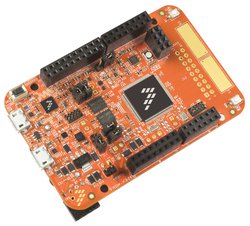
Overview¶
The FRDM-K82F has been designed by NXP in collaboration with Mbed for prototyping all sorts of devices, especially those requiring the size and price point offered by Cortex-M4. The board is well sized for low-power applications, thanks to its power efficient Kinetis K82 MCU featuring an ARM® Cortex®-M4 core running up to 150MHz and embedding 256KB Flash, 256KB RAM. Features on FRDM-K82F include but not limited to dual-role USB interface, QuadSPI memory and headers for use with Bluetooth® and 2.4 GHz radio add-on modules. The Kinetis K82 MCU family remains fully software, hardware and development tool compatibility with other Kinetis MCU and Freedom board families. It is packaged as a development board including extension headers compatible with Arduino R3 shields and includes a built-in USB Debug and Flash Programmer.
Features in Development
Support for the following features of FRDM-K82F are currently in development in Mbed OS. Schedule for release is TBD.
- QuadSPI
- USB Device
- SDHC
- Hardware cryptographic accelerators
MCU Features¶
- Kinetis MK82FN256VLL15 in 100 LQFP package
- Performance
- ARM® Cortex™-M4 32-bit core with DSP instructions and Floating Point Unit (FPU)
- 150 MHz max CPU frequency
- Memory and memory expansion
- 256 KB program flash memory
- 256 KB RAM
- Dual QuadSPI with OTF decryption and XIP
- FlexBus external bus interface and SDRAM controller
- 32 KB Boot ROM with built in bootloader
- System peripherals
- Multiple low-power modes
- Memory protection unit with multi-master protection
- 32-channel enhanced direct memory access (eDMA) module
- Clocks
- 3 to 32 MHz main crystal oscillator
- 32 kHz low power crystal oscillator
- 48 MHz internal reference
- Analog modules
- 1x 16-bit ADC
- 1x 12-bit DAC
- 2x Analog comparators
- Voltage reference 1.2 V
- Communication interfaces
- 1x USB full-speed OTG
- 1x Secure Digital Host Controller (SDHC)
- 1x I2S module
- 3x SPI modules
- 4x I2C modules
- 5x LPUART modules
- 2x EMVSIM module
- 1x FlexIO
- Timers
- 1x 4 channel-Periodic interrupt timer
- 2x 16-bit low-power timer PWM modules
- 2x 8-channel motor control/general purpose/PWM timers
- 2x 2-channel quadrature decoder/general purpose timers
- Real-time clock with independent 3.3 V power domain
- Programmable delay block
- Security and integrity modules
- Hardware accelerators supporting AES, DES, 3DES, SHA, RSA and ECC (LTC or CAU)
- Hardware CRC and true random-number generator modules
- Multiple levels of embedded flash security
- 128-bit unique identification number per chip
- Human machine interface
- Low-power hardware touch sensor interface (TSI)
- General-purpose I/O
- Operating Characteristics
- Main VDD Voltage and Flash write voltage range:1.71 V–3.6 V
- Independent VDDIO for PORTE (QuadSPI): 1.71 V–3.6 V
Board Features¶
- Onboard Components
- FXOS8700CQ - Accelerometer and Magnetometer
- MX25U3235FZNI - dual 32 Mb (4MB) QuadSPI Memory
- 2 user push-buttons
- RGB LED
- Connectivity
- Dual role Full-speed USB interface with micro-B USB connector
- up to 4x UARTs, 3x SPIs, 4x I2Cs and 1xI2S connected to Headers (multiplexed peripherals)
- Extensions
- Headers compatible with Arduino R3 shields (32-pins / outter row)
- Headers for proprietary shields (32-pins / inner row)
- FlexIO Header compatible with OV7670 Camera
- Optional header for add-on RF module: RF24L01+ Nordic 2.4 GHz Radio
- Optional header for add-on Bluetooth module: JY-MCU BT Board V1.05 BT
- Analog and Digital IOs (multiplexed peripherals)
- 1x ADC 16-bit resolution with 14 Analog I/O Pins connected to Headers
- up to 6x timers with 24 PWM signals accessible from Headers
- up to x8 Comparator Inputs or 1x DAC outputs
- up to 44 MCU I/O Pins connected to Headers (3.3v)
- up to 2 capacitive pads connected to touch-sensing input (TSI) module
- Board power-supply options (onboard 5 to 3.3V regulator)
- USB Debug 5V
- USB Target 5V
- 5-9V Vin on Arduino headers
- 3.3V/5V PWR input
- Coin-cell 3.3V
- Integrated OpenSDA USB Debug and Programming adapter
- Several industry standard Debug interfaces (PEmicro, CMSIS-DAP, JLink)
- Drag-n-drop MSD Flash-programming
- Virtual USB to Serial Port
- Form factor: 3.2” x 2.1” / 81mm x 53mm
- Software Development Tools
- Mbed HDK & SDK enabled
- Online development tools
- Easy to use C/C++ SDK
- Lots of published libraries and projects
- Alternate Offline options NXP free MCUXpresso IDE (compiler toolchain) and MCUXpresso SDK library/examples
- Supplier website: http://www.nxp.com/frdm-k82f
Board Block Diagram¶
The graphic below gives an overview of the board features and the connection between the target MCU and the on-board components and connectors
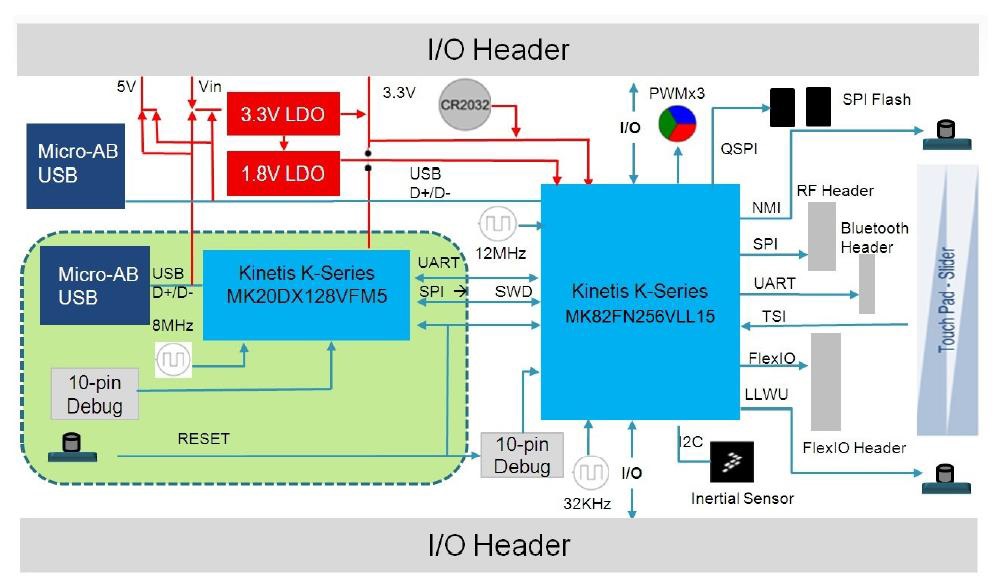
Board Pinout¶
Component Pinout¶
Following figure indicates the Kinetis K82 signal connections with the board components (RGB LED, Motion Sensor) and extension connectors (QuadSPI Flash, Camera Expansion Board, Bluetooth and RF headers).
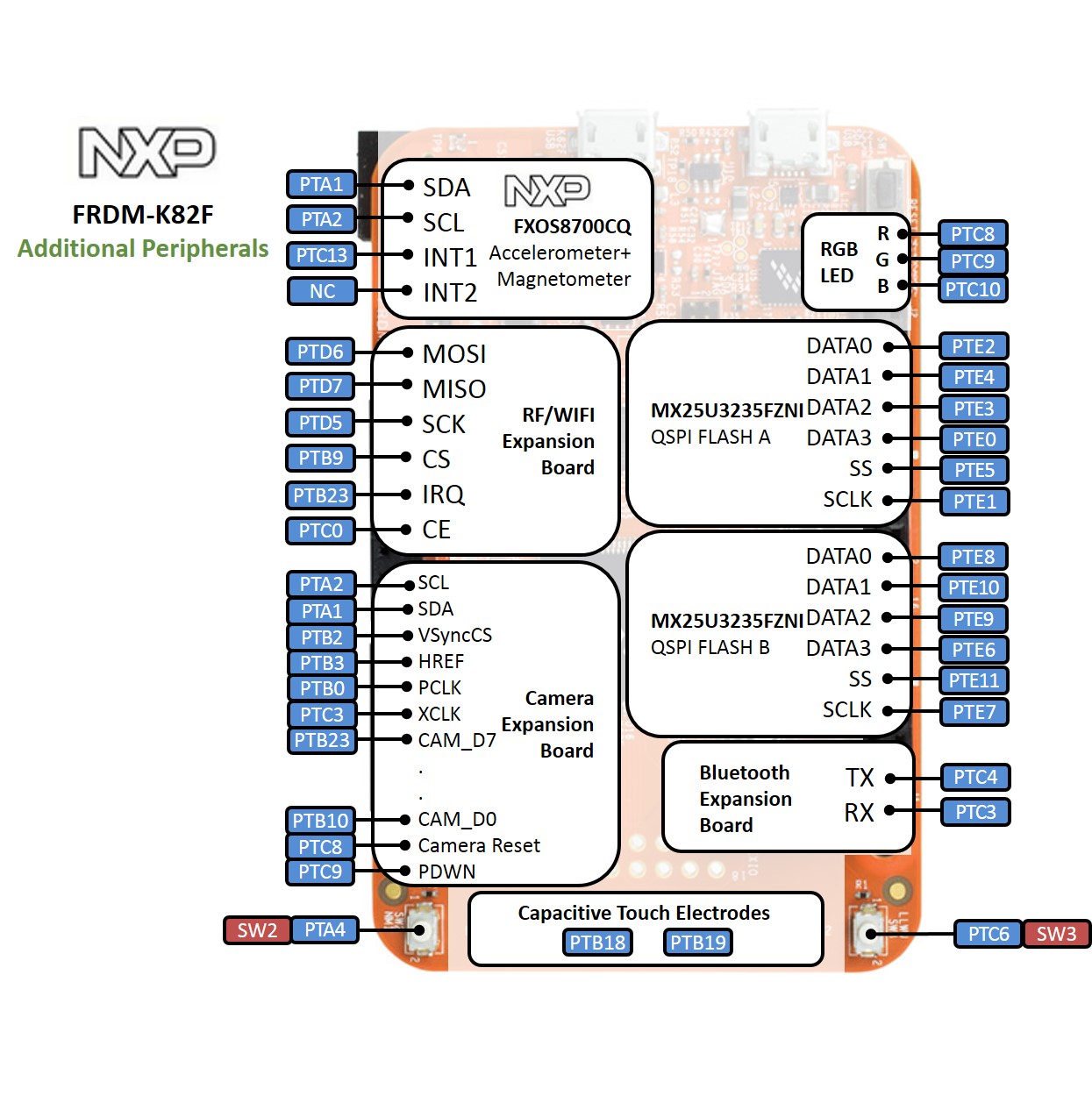
Arduino and NXP Header Pinout¶
Freedom board headers enable up to 64-pins and give access to most of the Kinetis K82 signals
- Outer row pins deliver right signals to meet Arduino R3 standard
- Inner row is connected to up to 32 additional Kinetis K82 pins
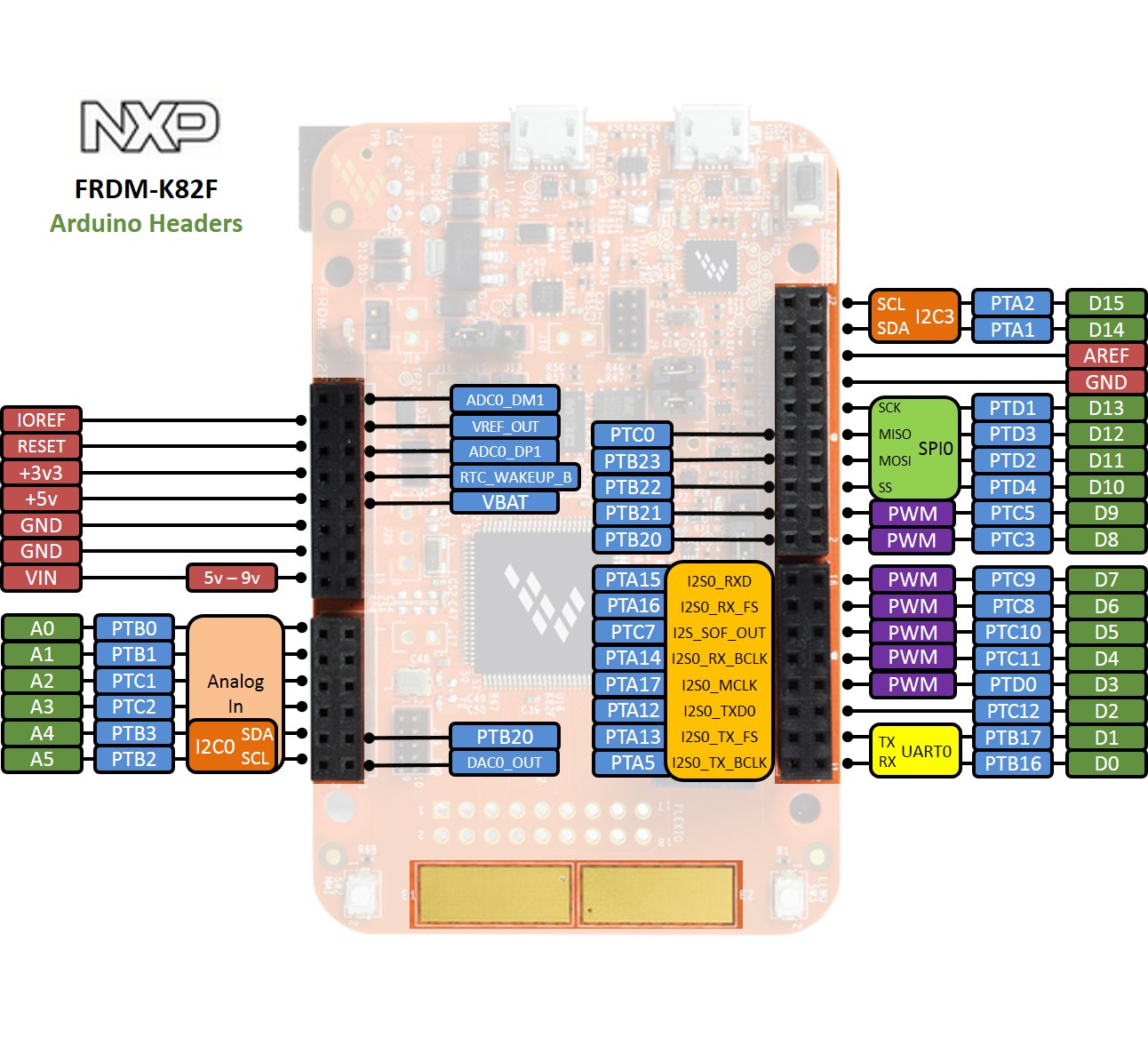
Important Notes
Please note that on this MCU in SPI Slave mode pins labeled MOSI behave as Slave Output and pins labeled MISO behave as Slave Input. The terms MOSI (Master Out Slave In) and MISO (Master In Slave Out) only apply to Master mode.
The FRDM-K82F is fully supported in the Mbed platform, so it gets access to the free tools and SDK that provides experienced embedded developers with powerful and productive tools for building proof-of-concepts. The pinout above shows the commonly used interfaces and their locations. Note that all the numbered pins (PT_XX) can also be used as DigitalIn and DigitalOut interfaces.
Pin names¶
PC Configuration¶
Your Mbed Microcontroller can appear on your computer as a serial port. On Mac and Linux, this will happen by default. For Windows, you need to install a driver:
Windows
See Windows-serial-configuration for full details about setting up Windows for serial communication with your Mbed Microcontroller
From a host PC to communicate with Mbed you will need a terminal application. This allows the Mbed Microcontroller to print to your PC screen, and for you to send characters back to your Mbed.
- Terminals - Using Terminal applications to communicate between the Host PC and the Mbed Micrcontroller
Some terminal programs (e.g. TeraTerm) list the available serial ports by name. However, if you do need to know the identity of the serial port so that you can attach a terminal or an application to it:
Firmware Update¶
FirmwareUpdate
A new interface firmware image is necessary to Mbed-enable NXP FRDM boards
For FRDM-K82F, at the following link, choose CMSIS-DAP firmware that is compatible with OpenSDA v2.1 bootloader.
Quick Summary: hold down the reset button, plug in the usb cable to the OpenSDA usb connection, copy the new interface firmware to the enumerated drive, done!
Get Started with Mbed¶
First board connection¶
Use the USB lead to connect your Mbed to a PC. The status light will come on, indicating it has power. After a few seconds of activity, the PC will recognize the Mbed Microcontroller as a standard USB drive.
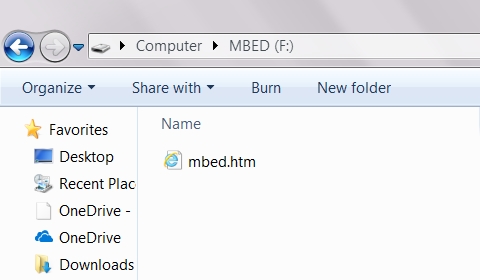 | 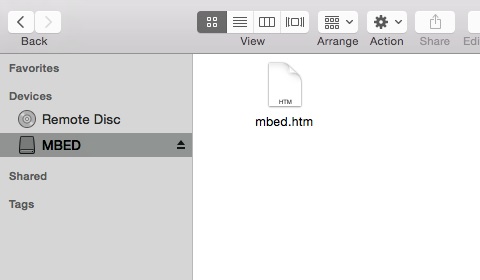 |
| Windows 7 example | Mac OS X example |
Flash a project binary¶
1. Download a (.bin) to the FRDM Platform¶
Download the appropriate "Hello World!" binary:
- NXP FRDM-K82F: HelloWorld_K82F.bin
Note: the source code for this program will be seen in the next section.
Save the program binary file to your Mbed Microcontroller Disk, just like you would with a normal USB disk. The Status LED will flash as the PC writes the file to the Microcontroller disk.
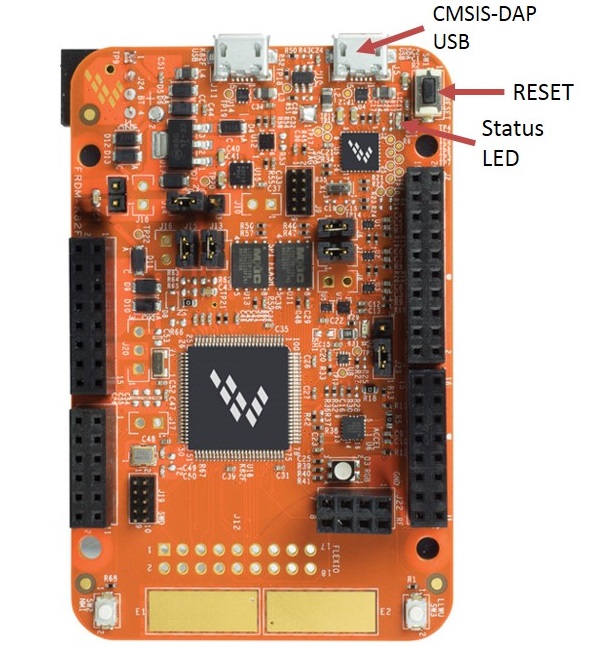
2. Press the Reset Button¶
When the Reset Button in pressed, the newest program on the Mbed Microcontroller Disk will be loaded in to the Microcontroller FLASH memory. The Status LED will flash as this happens.
When the program is has been loaded onto the microcontroller, it will then start it running.
3. Run Hello World!¶
The Microcontroller is now running the program; flashing LED1 forever! If you reset the Microcontroller, or disconnect and reconnect the power, the program will simply restart.
4. Flash a new precompiled program¶
It is the newest program on the Mbed Microcontroller that is run after reset. We can therefore download a new program or overwrite an existing one to update the program that will run.
Open existing Project¶
1. Import the Program to your Mbed compiler¶
Select Import As Program
Choose Import Name of your preference
Click on Import
[Repository '/teams/mbed-os-examples/code/mbed-os-example-blinky/' not found]
2. Compile the Program¶
In the right panel Program Workspace Select the program you want to compile
Click on Compile in toolbar
If compilation ends successfully, you should see the comment Success! displayed in the Compile Output window available in the bottom and your web browser should download automatically the precompiled binary for the program.
3. Download a (.bin) to the FRDM Platform¶
Save the program binary file to your Mbed Microcontroller Disk, just like you would with a normal USB disk. The Status LED will flash as the PC writes the file to the Microcontroller disk.
4. Press the Reset Button¶
When the Reset Button in pressed, the newest program on the Mbed Microcontroller Disk will be loaded in to the Microcontroller FLASH memory. The Status LED will flash as this happens.
When the program is has been loaded onto the microcontroller, it will then start it running.
5. Run the Program¶
The Microcontroller is now running the program; flashing LED1 forever! If you reset the Microcontroller, or disconnect and reconnect the power, the program will simply restart.
Program Examples
Congratulation, you have successfully compiled your first project example, you will find more program examples for the FRDM-K82F board available on the right panel of this page or at the NXP code repositories
Create new Project¶
Follow the guide to creating your own programs using the online compiler
Technical Doc¶
FRDM-K82F Board¶
- User's Guide
- Schematic rev B2
- User's Guide - Getting Started with the Kinetis ROM Bootloader - KBTLDRUG
- User's Guide - Getting Started with Kinetis® SDK (KSDK) v.1.3
Kinetis K82F MCU¶
- Fact Sheet
- Data Sheet
- Reference Manual
- Kinetis® Bootloader v2.0.0 Reference Manual
- Errata
- Application Note - Offline Flash Programmer for Kinetis K- and L-series MCUs
- Application Note - Using Kinetis FlexIO to Drive a Graphical LCD
- Application Note - Using FlexIO for parallel Camera Interface
- Application Note Software - Application Note Software for AN5331
- User's Guide - Kinetis Bootloader QuadSPI User's Guide
FXOS8700 Motion Sensor¶
MX25U3235FZNI - Serial Multi I/O Flash¶
Where to buy¶
You need to log in to post a discussion
